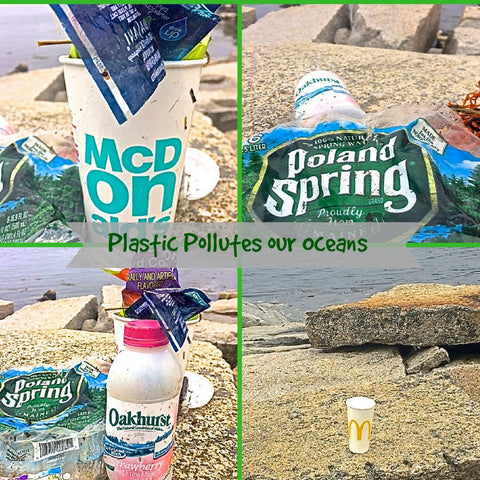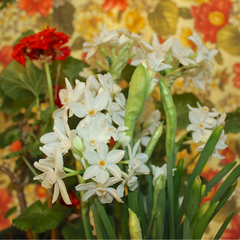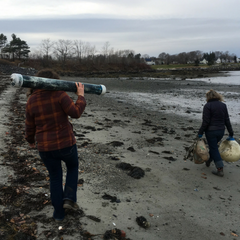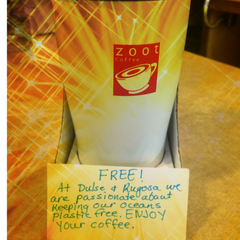News — World Ocean Day
Plastic Free July
This month- there is a world wide movement- Plastic Free July with the goal of raising awareness and challenging people to do something about single use plastic. Single use plastic is plastic that is essentially used one time and then discarded. Straws, coffee cups, lids, take out containers. Basically anything that is convenient, quick and saves time.
It's not that plastics are inherently evil. The Plastic Free July organization has a really interesting perspective on plastics- "Plastics were developed in the early 20th century and were environmentally important, replacing ivory, tortoiseshell, horn and other plant and animal products. By the 1960's plastic had gone from being used in durable items to widespread use including disposable plastic packaging." When you think about all the plant and animal products that have been saved you realize plastics have a place in our society and often especially with medicine and agriculture the benefits of plastic can make life better.
The problem is we have too much of a good thing. We are simply using way, way, way too much plastic- it's everywhere and it's created a host of problems. "Everypiece of plastic ever produced still remains somewhere in the earth today. In the last half of the 20th century over 1 billion tons of plastic was produced. This figure has already doubled in the first ten years of this century." One of the biggest culprits is single use plastic, in the USA over 500 million straws are used daily. 
And while many people recycle household plastic, single use plastic is the least likely to be recycled. We tend to use these plastic products at events, concerts and while traveling. Often our recycled plastic is sent to a developing country where we can't see it but it's still there. There may also be health issues related to plastic especially with food stored or cooked in plastic. And finally just the trash that is filling our land and oceans. Plastic pollution in the oceans affects all sea creatures. According to the Ocean Conservancy the biggest source of ocean pollution is plastic beverage containers. They break down into smaller and smaller pieces and are often mistaken for food by hungry animals.
The best way to get started on your Plastic Free Journey is to visit Plastic Free July and take the Pesky Plastic Quiz. Answering the questions will give you a great starting place to make a change in your life. I guarantee once you get started you won't look back.
Resources to get you started-
From the Plastic Free Mermaid a free downloaded e-book Plastic Free July Guidebook
Another resource from Treading My Own Path has Enough is Enough- 18 Ideas for Embracing a Life With Less Waste and Less Stuff. She also writes great blogs with practical tips, her latest is How to Buy Milk, Yogurt and Cheese Without Plastic.
Follow Australian writer and activist Anita Horn on Facebook, her page is devoted to Plastic Free Produce. It's an easy one to start because many of our fruits and vegetables are beautifully packaged by Mother Nature.
Protect Our Oceans Every Day- Simple Tips to Reduce Plastic Consumption
World Ocean Day 2015 was when I moved from awareness to activism both personally and in business. Thanks to a FaceBook post by the Lonely Whale Foundation. It was the handsome face of Adrian Grenier who played Vince on the TV show Entourage that caught my eye. Of course, there is always that disconnect between a favorite character on a TV show and the actual actor. In Entourage, Grenier plays an up and coming celebrity who definitely buys into the consumption lifestyle. It was a pleasant surprise to see him talking about plastic straws and his passion for the ocean.

The truth is our oceans are being polluted with needless plastic. This includes water bottles, straws, plastic bags, drink cups, coffee lids and balloons. Everyday items that most of us don't think about using. The problem with plastic compared to other materials is it really never goes away. It just keeps breaking down into tiny, little pieces. Often these pieces look like a tasty morsel to a jellyfish, turtle or seabird. That's the problem our planet is facing.
A few simple steps can make a difference.
Stop drinking water from plastic bottles- Invest in a reusable water bottle and use it. For more info check out Ban the Bottle.

Say "NO" to plastic straws. We use 500 million straws daily in the USA. Companies now make stainless steel or bamboo straws both washable and reusable. Checkout the Strawless Ocean for more plastic straw data.
Purchase a refillable coffee cup- You can use a refillable cup anywhere, this includes independent coffee shops, gas station quick shops and even big franchises including Dunkin donuts and Starbucks. Even the Starbucks in the busy Kennebunk Rest Stop will make whatever yummy coffee drink you want in your refillable mug.
Skip the lid- if you have to use a single use coffee cup don't use the lid, it's one less piece of unnecessary trash.
Celebrate naturally- The problem with balloons is the bits and pieces often look like food for hungry critters and the strings often entangle and even kill wildlife. Our joyous celebrations shouldn't harm wildlife or pollute our planet. The organization Balloons Blow has over 20 environmentally friendly alternatives to balloons. My favorites are bubbles and ribbon streamers.
I know how hard it can be to make changes. Sipping from a straw is something we don't think about- you have to make a conscious effort and expect to fail at times. One of the best ways to move from awareness to activism is to pick up trash. Next time you are out for a walk or hike, notice what trash is around. Chances are it's water bottles, fast food cups, lids and straws and other types of connivence foods. It's actually shocking. And document your find by taking a picture and posting it with Just Grab Bits and you'll be entered to win cool, eco-friendly prizes including our own plastic free Dulse & Rugosa shampoo bars.
Start your zero waste journey today- small steps lead to big changes.
Easy Tips To Help You Go Plastic Free and Zero Waste
2017 is the year to begin your plastic free journey. New Year resolutions can be tough, for me it helps if they are structured for success. Small steps work best. I don’t recommend giving up plastic “cold turkey”- that’s guaranteed to be frustrating. Instead each month or so, give up one type of single use plastic and before you know it you’ll be a Zero Waste Warrior.
Plastic free is all about limiting your use of plastic to essentials and eliminating single use plastic. Single use plastic is plastic that is used once and then discarded- straws, coffee cups, drink lids, water bottles, grocery bags………. Zero waste is a philosophy that focuses on rethinking how we live in order to produce as little waste as possible.
Here are more than 12 steps that you can take to help you on your plastic free journey. Mix them up, start with one that is easy for you and save the harder ones for later. I guarantee by this time next year, you will be proud of your new habits and view purchases entirely differently.
- Educate yourself. The more you know, the more motivated and committed you will be to keep your resolutions to be plastic free and zero waste.
- Give up plastic grocery bags. Bring your own and if you forget only buy enough to carry easily in your hand. I find it helpful to keep a lightweight bag in my purse.
- Reusable bags for ALL purchases. Once you master reusable grocery bags make it a policy to not use any plastic bags for any purchase. It's easy once you get started.
- Switch to reusable coffee cups. When my life is routine this is easy, when it gets chaotic it's quite a challenge. One tip is to buy more than one reusable cup , that way if one is dirty or lost in the car you can still enjoy a coffee.
- Stop buying plastic water bottles. The first thing you have to do is buy a reusable water container and carry it where ever you go- including airports.
- Buy in bulk. This is a critical step in moving towards zero waste. Instead of buying 6 small yogurt containers for the week, buy one large. Before you know it you'll be investigating local farms that sell yogurt in reusable jars.
- Plastic Free Produce. Produce does not need to be wrapped in plastic and often produce is over packaged. I found I needed to support a few stores in order to buy all my produce plastic free and to invest and make some reusable produce/bulk bags. My habits have changed- and yes it does take a bit longer to make a salad than simply opening a plastic package.
- Replace paper napkins and towels with cloth. Your one time purchase of napkins will last for years. Using washable cloths for most clean up jobs and saving paper towels for big messes will help you cut down on waste.
- Rethink soap, shampoos and other personal care items. The personal care aisle in a grocery store is loaded with plastic packaging. Instead of a plastic bottle of liquid soap switch to a bar. Try a shampoo bar instead of a plastic bottle of shampoo and conditioner.
- Invest in reusable food containers. Pack lunches, picnics and when ordering take away bring your own container. Sure you might wait a few minutes but it's a great chance to catch up on your social media while you wait.
- Switch to bamboo toothbrushes. Remember plastic never biodegrades because it's not part of Mother Nature's food chain.
- Give up disposable razors. Invest in a razor that will last a life time.
- Switch to glass or metal containers for food storage. When your plastic food storage containers wear out switch to glass or metal. But wait for them to wear out, it's wasteful to simply throw something away. Use it up first and then take it to be recycled.
- Replace plastic wrap and aluminum foil with beeswax or cloth. I often wrap a tea towel around my serving bowl before putting in the fridge. You could also invest in a few glass containers with lids. Glass really helps keep track of your food 'cause you can see what you're saving.
- Compost. Composting your food really helps cut down on unnecessary waste.
- Pick up trash. There's nothing like picking up a bit of trash to firm your resolve to be plastic free and to embrace the zero waste philosophy.
- Finally, make purchasing decisions based on packaging. Whenever possible purchase items with less packaging. Support businesses that are working on reducing waste. Shop local, shop small.
Have a Holly, Trash Free Holiday and a Plastic Free New Year
Since World Ocean Day a few years ago I have worked hard to reduce my footprint both in my personal life and in business. The holiday season brings special challenges. Part has to do with memories, I was talking with a friend recently about gift wrapping. She said, "I love to wrap gifts, it's part of my Christmas season." But- how we choose to wrap makes a big difference. Elaborate, non biodegradable gift wrap leaves a lasting footprint. To help you have a trash free holiday I've listed 14 ways to hopefully get that holiday glow without the trash.
#1 Buy Well- Choose Less When shopping for gifts, resist the impulse to buy a cute but useless item that will not linger after the holiday. Check out how items are packaged. My daughter loves gummy bears- I can buy a cute plastic package of bears, a reusable bear mason jar filled with gummies or take a cloth bag to the candy shop on Main Street. What's important to remember is you have choices.
#2 Shop small, shop local. Supporting small, indies businesses lets your money continue to work long after you've spent it. You can find companies that support your values and are working hard to reduce their business footprint.
#3 Even if you have decided to limit your holiday purchases or to make donations to worthy causes help out indie business by supporting them in other ways- especially on social media. Our blog post Make Your Money Count and Use Less Plastic gives practical tips.
#4 Purchase lasting gifts that help reduce everyday waste. Reusable coffee mugs, bamboo straws, shopping bags, produce bags, shampoo bars and bamboo toothbrushes.
#5 Wrap your gifts in cloth, brown paper lunch bags, newspaper or tissue paper made from recycled paper. Easy to recycle or compost.
#6 Give the gifts of plants. Paperwhite bulbs are especially lovely during the winter months.

Amaryllis bulbs create a splash of color and I plant mine out in the garden every summer so many of my bulbs are 4 years old and going strong. A seed sprouting jar is a low waste way to have fresh tasty greens in salads and sandwiches all winter long.
#7 Gift certificates make in possible for folks to get just what they need or want and if they are from small, indie businesses the good keeps going.
#8 Donations are a great way to spread the love. Choose your favorite organizations and let them start the New Year ready to get important work done.
#9 Give the gift of an experience. Every year I treat my family to New Year's Day brunch at our local farm to table restaurant. I love starting the New Year in a bustling restaurant with a Passionfruit Margarita, a basket of home baked breads and the lively conversations of my loved ones.
#10 Look around the house for items to regift. Sometimes regifting has a tacky connotation but it's a perfect way to reduce and reuse. While cleaning recently I found a huge stash of yarn bits. Someone will be happily knitting all winter long.
#11 While you are rummaging for regifts, clean out the closets and pass useful used items to the appropriate charities.
#12 Give the gift of clean and get outside and pick up some trash. Believe me- it's everywhere. Check out the organization Just Grab Bits . I especially love their Instagram page- it's a bittersweet trashy tour around the world.

#13 Decorate with natural materials including evergreen, pine cones and berries. If you are buying decorations make sure they are well made and will be used and loved for many years. Completely avoid balloons, "they kill wildlife, pollute the earth and waste helium". Check out Balloons Blow- Don't Let Them Go for more information.
#14 Give a subscription. Fact checking is expensive and subscriptions show support and help attract advertisers.
My final tip is the one I've had the most fun with. I want to help people make the transition to plastic free as easy as possible. Two areas I struggle with are single use coffee cups and plastic free produce. I have started "Random Acts of Awareness". I purchase reusable mugs from my favorite coffee shops (helping to keep it local) and then leave them on the counter for someone ordering a take away coffee in a single use cup.

I'm almost ready to do the same thing with some homemade produce bags. Over the Thanksgiving holiday I cut up an old sheet and put together a bunch of cloth produce bags. They are almost ready to be donated to shoppers reaching for a plastic bag in the produce department. Learn more about the plastic free produce movement by visiting Australian Anita Horn's Facebook page.
Happy Trash Free Holidays!





